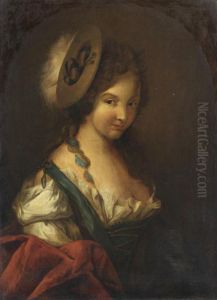Giovan Angelo Borroni Paintings
Giovan Angelo Borroni was an Italian painter born in 1684 in Busto Arsizio, a town in the northern region of Lombardy. He is not as widely known as some of his contemporaries, and information about his life and work is relatively sparse. Nevertheless, Borroni made a modest contribution to the Italian Baroque movement, which was waning during his lifetime as the Rococo style began to emerge.
Borroni's initial training in the arts is not well-documented, but it is believed that he began his artistic journey in Milan. Later, he moved to Bologna, which was a significant center of artistic activity at the time. There, he was likely exposed to the works of prominent Baroque artists, which would have influenced his painting style. Borroni's work was characterized by the dramatic use of light and shadow, a hallmark of the Baroque aesthetic, and a dynamic composition, yet he also incorporated a softer and more decorative element that hinted at the early Rococo sensibility.
During his career, Borroni was active primarily in Northern Italy. He worked on religious commissions for various churches, contributing altarpieces and frescoes. His paintings often depicted scenes from the life of Christ, the Virgin Mary, and the saints. Despite the religious nature of his work, Borroni's art also reflected the changing tastes of the period, showing an appreciation for the ornamental and the theatrical, which were gaining popularity among patrons and the art-loving public.
Borroni's legacy is modest compared to that of the grand masters of Italian art, and many of his works have been overshadowed by those of more famous artists. However, his contributions to the churches and institutions for which he worked remain part of the fabric of Italian cultural heritage. Giovan Angelo Borroni passed away in 1772. His works can still be viewed in situ and in various art collections, where they continue to be studied for their place in the transition between the Baroque and Rococo periods.
